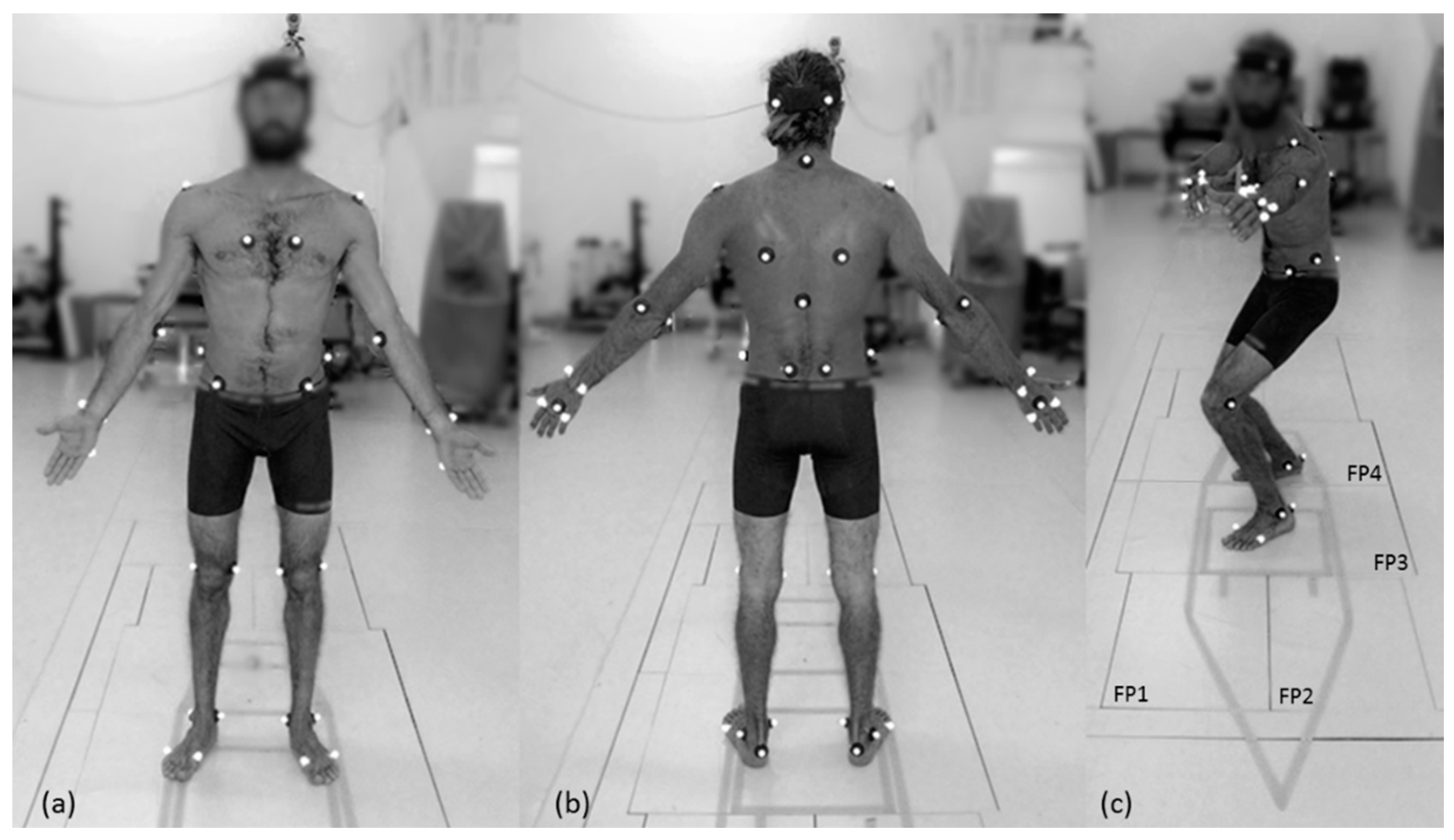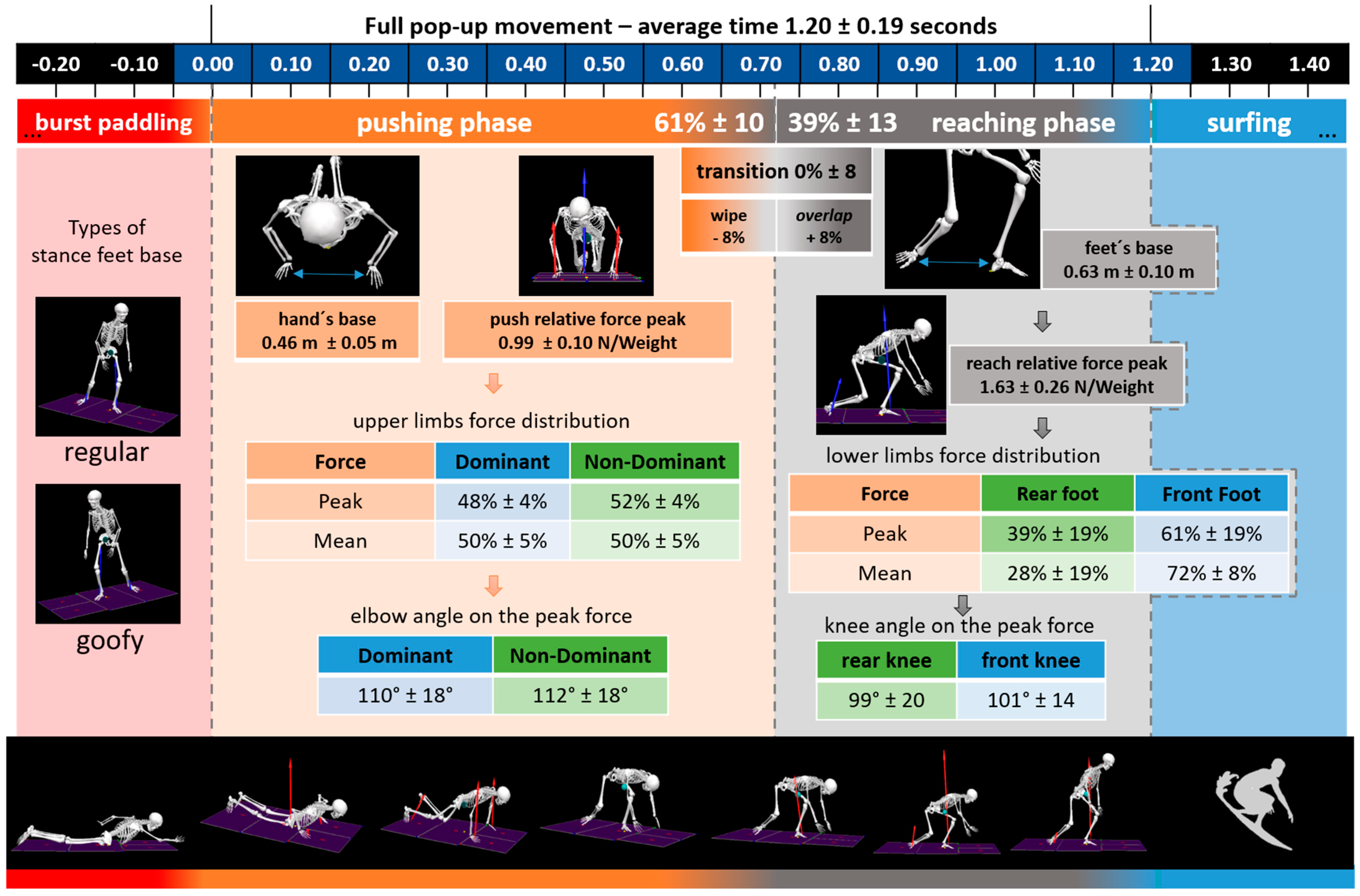Are the Kinetics and Kinematics of the Surf Pop-Up Related to the Anthropometric Characteristics of the Surfer?
Abstract
:1. Introduction
2. Materials and Methods
2.1. Participants
2.2. Experimental Procedures
2.3. Data Processing and Analysis
2.4. Statistical Analysis
3. Results
3.1. Kinematics
3.2. Ground Reaction Force
3.3. Anthropometry
4. Discussion
4.1. Push-Up Phase
4.2. Transition Phase
4.3. Reaching Phase
4.4. Limitations
5. Conclusions
Author Contributions
Funding
Institutional Review Board Statement
Informed Consent Statement
Data Availability Statement
Conflicts of Interest
References
- Mendez-Villanueva, A.; Bishop, D. Physiological Aspects of Surfboard Riding Performance. Sports Med. 2005, 35, 55–70. [Google Scholar] [CrossRef] [PubMed]
- Everline, C. Shortboard Performance Surfing: A Qualitative Assessment of Maneuvers and a Sample Periodized Strength and Conditioning Program In and Out of the Water. Strength Cond. J. 2007, 29, 32–40. [Google Scholar] [CrossRef]
- Eurich, A.D.; Brown, L.E.; Coburn, J.W.; Noffal, G.J.; Nguyen, D.; Khamoui, A.V.; Uribe, B.P. Performance Differences between Sexes in the Pop-Up Phase of Surfing. J. Strength Cond. Res. 2010, 24, 2821–2825. [Google Scholar] [CrossRef] [PubMed]
- Hammer, R.L.; Loubert, P.V. Alternative Pop-Up for Surfers with Low Back Pain. North Am. J. sports Phys. Ther. NAJSPT 2010, 5, 15–18. [Google Scholar]
- Wilson, G.W.; Özkan-Haller, H.T.; Holman, R.A.; Haller, M.C.; Honegger, D.A.; Chickadel, C.C. Surf zone bathymetry and circulation predictions via data assimilation of remote sensing observations. J. Geophys. Res. Oceans 2014, 119, 1993–2016. [Google Scholar] [CrossRef] [Green Version]
- Rochelle, R.D.; Horvath, S.M. Thermoregulation in surfers and nonsurfers immersed in cold water. Undersea Biomed. Res. 1978, 5, 377–390. [Google Scholar]
- Lowdon, B. Fitness requirements for surfing. Sports Coach 1983, 6, 35–38. [Google Scholar]
- Moreira, M.; Peixoto, C. Qualitative Task Analysis to Enhance Sports Characterization: A Surfing Case Study. J. Hum. Kinet. 2014, 42, 245–257. [Google Scholar] [CrossRef] [PubMed] [Green Version]
- Secomb, J.L.; Sheppard, J.M.; Dascombe, B.J. Time–Motion Analysis of a 2-Hour Surfing Training Session. Int. J. Sports Physiol. Perform. 2015, 10, 17–22. [Google Scholar] [CrossRef] [PubMed]
- Farley, O.R.; Abbiss, C.R.; Sheppard, J.M. Performance Analysis of Surfing: A Review. J. Strength Cond. Res. 2017, 31, 260–271. [Google Scholar] [CrossRef]
- Minahan, C.L.; Pirera, D.J.; Sheehan, B.; Macdonald, L.; Bellinger, P.M. Anaerobic Energy Production During Sprint Paddling in Junior Competitive and Recreational Surfers. Int. J. Sports Physiol. Perform. 2016, 11, 810–815. [Google Scholar] [CrossRef]
- Forsyth, J.R.; de la Harpe, R.; Riddiford-Harland, D.L.; Whitting, J.W.; Steele, J.R. Scoring analysis of manoeuvres performed in elite male professional surfing competitions. Int. J. Sports Physiol. Perform. 2017, 2, 1243–1248. [Google Scholar] [CrossRef]
- Sinclair, W.H.; Leicht, A.S.; Eady, T.W.; Marshall, N.J.; Woods, C.T. Identifying the physical and anthropometric qualities explanatory of paddling adolescents. J. Sci. Med. Sport 2017, 20, 1112–1116. [Google Scholar] [CrossRef]
- Anthony, C.C.; Brown, L.E.; Coburn, J.W.; Galpin, A.J.; Tran, T.T. Stance affects balance in surfers. Int. J. Sports Sci. Coach. 2016, 11, 446–450. [Google Scholar] [CrossRef]
- De Gamboa, I.F.; Javier, Y.; Granados, C.; Jesus, C. Comparison of anthropometry and lower limb power qualities according to different levels and ranking position of competitive surfers. J. Strength Cond. Res. 2017, 31, 2231–2237. [Google Scholar] [CrossRef]
- Barlow, M.J.; Findlay, M.; Gresty, K.; Cooke, C. Anthropometric variables and their relationship to performance and ability in male surfers. Eur. J. Sport Sci. 2011, 14, S171–S177. [Google Scholar] [CrossRef] [PubMed]
- Hayes, K.C. Biomechanics of Postural Control. Exerc. Sport Sci. Rev. 1982, 10, 363–391. [Google Scholar] [CrossRef]
- Winiarski, S.; Rutkowska-Kucharska, A.; Pozowski, A.; Aleksandrowicz, K. A New Method of Evaluating the Symmetry of Movement Used to Assess the Gait of Patients after Unilateral Total Hip Replacement. Appl. Bionics Biomech. 2019, 2019, 1–11. [Google Scholar] [CrossRef] [PubMed] [Green Version]




| N = 23 | Stance Feet Base | ||
|---|---|---|---|
| Hand Dominance | Regular | Goofy | Total |
| Right | 10 | 7 | 17 |
| Left | 2 | 4 | 6 |
| Total | 12 | 11 | 23 |
Publisher’s Note: MDPI stays neutral with regard to jurisdictional claims in published maps and institutional affiliations. |
© 2021 by the authors. Licensee MDPI, Basel, Switzerland. This article is an open access article distributed under the terms and conditions of the Creative Commons Attribution (CC BY) license (http://creativecommons.org/licenses/by/4.0/).
Share and Cite
Borgonovo-Santos, M.; Telles, T.; Nessler, J.; de Castro, M.P.; Fernandes, R.J.; Vilas-Boas, J.P. Are the Kinetics and Kinematics of the Surf Pop-Up Related to the Anthropometric Characteristics of the Surfer? Sensors 2021, 21, 1783. https://doi.org/10.3390/s21051783
Borgonovo-Santos M, Telles T, Nessler J, de Castro MP, Fernandes RJ, Vilas-Boas JP. Are the Kinetics and Kinematics of the Surf Pop-Up Related to the Anthropometric Characteristics of the Surfer? Sensors. 2021; 21(5):1783. https://doi.org/10.3390/s21051783
Chicago/Turabian StyleBorgonovo-Santos, Márcio, Thiago Telles, Jeff Nessler, Marcelo Peduzzi de Castro, Ricardo J. Fernandes, and João Paulo Vilas-Boas. 2021. "Are the Kinetics and Kinematics of the Surf Pop-Up Related to the Anthropometric Characteristics of the Surfer?" Sensors 21, no. 5: 1783. https://doi.org/10.3390/s21051783
APA StyleBorgonovo-Santos, M., Telles, T., Nessler, J., de Castro, M. P., Fernandes, R. J., & Vilas-Boas, J. P. (2021). Are the Kinetics and Kinematics of the Surf Pop-Up Related to the Anthropometric Characteristics of the Surfer? Sensors, 21(5), 1783. https://doi.org/10.3390/s21051783









